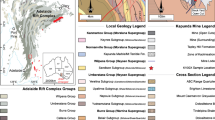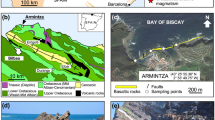Summary
Three types of late, subsolidus (K-Rb)-feldspars occur in the spodumene-subtype, complex-type, pollucite-bearing Rubellite rare-element pegmatite at Lilypad Lakes, near Fort Hope in northwestern Ontario: (1) Exsolution followed by hydrothermal reconstitution generated diffuse bands, patches and veinlets of Rb-enriched (< 43 mol. % Rbf) and Rb-depleted triclinic K-feldspar in black blocky microcline; (2) metasomatism of pollucite produced aggregates of adularia which range from 14 to 73 mol.% Rbf, rimmed by pure 100 mol.% Kfs feldspar, and are most likely highly disordered; (3) blocky K-feldspar was replaced by salmon-coloured, fine-grained, Na-poor and Rb-free maximum microcline with a composition close to 100 mol.% Kfs, associated with calcite and fluorite. After initial solid-state unmixing in blocky microcline, the reconstituted and metasomatic (K-Rb)-feldspars of the first two types could have formed simultaneously, under the influence of the same aqueous fluid. The exsolved and reconstituted Rb-rich feldspar inherited the (Al,Si)-ordered framework of the blocky precursor, whereas metasomatic neocrystallization generated metastable disordered (K-Rb)-adularia. In contrast, a different, F- and CO3-rich fluid produced the metasomatic salmon-coloured K-feldspar, and promoted its perfect (Al,Si)-order.
Zusammenfassung
In dem Pollucit and seltene Elemente führenden Rubellit-Pegmatit (Spodumen-Subtyp, komplexer Typ) bei Lilypad Lakes, nahe Fort Hope in Nordwest-Ontario kommen drei Typen von späten (K,Rb)-Feldspäten vor: (1) Entmischung gefolgt von hydrothermaler Rekonstitution schuf diffuse Bänder, Flecken and Gdngchen von an Rb angereicherten (< 43 Mol-% Rbf) and an Rb verarmtem triklinem K-Feldspat in schwarzem, blockigem Mikroklin; (2) Pollucit-Metasomatismus führte zur Bildung von Adular-Aggregaten mit von 14 bis 73 Mol-% Rbf, der von reinem 100 Mol-% Kfs gesäumt and höchst-wahrscheinlich stark ungeordnet ist; (3) blockiger K-Feldspat wurde durch lachsfarbigen, feinkömigen, Na-armen and Rb-freien maximalen Mikroklin mit einer Zusammensetzung nahe 100 Mol-% Kfs ersetzt, der mit Calcit and Fluorit vergesellschaftet ist. Nach der ursprünglichen Festkörperentmischung in blockigen Mikroklin konnten sich die neugebildeten und metasomatischen (K,Rb)-Feldspäte der beiden ersten Typen gleichzeitig and unter dem Einfluß des gleichen wäßrigen Fluides gebildet haben. Die entmischten and neugebildeten Rb-reichen Feläspdte erbten die (Al,Si)-Ordnung des Gerüstes des blockigen Vorläufers, während die metasomatische Neokristallisation metastabil ungeordnete (K,Rb)-Adulare bildete. Im Gegensatz dazu bildete ein F- und CO3-reiches Fluid den metasomatischen, lachsfarbigen K-Feldspat und verursachte seine vollständige (Al,Si)-Ordnung.
Similar content being viewed by others
References
Černý P (1979) Pollucite and its alteration in geological occurrences and in deep-burial radioactive waste disposal. In:Mc Carthy GJ (ed) Scientific basis for nuclear waste management, vol l. Plenum Publ Corp, New York, pp 231–236
Černý P (1994) Evolution of feldspars in granitic pegmatites. In:Parsons I (ed) Feldspars and their reactions, I. Kluwer Acad Publishers, Dordrecht Boston London, pp 501–540
Černý P, Chapman R (1984) Paragenesis, chemistry and structural state of adularia from granitic pegmatites. Bull Mineral 107: 369–384
Černý P, Chapman R (1986) Adularia from hydrothermal vein deposits: extremes in structural state. Can Mineral 24: 717–728
Chakoumakos BC, Lumpkin GR (1990) Pressure-temperature constraints on the crystallization of the Harding pegmatite, Taos County, New Mexico. Can Mineral 28: 287–297
Ginsburg AI 1960) Specific geochemical features of the pegmatite process. Internat Geol Congress, 21st Session Norden, Rept 17: 111–121
Henderson CMB, Manning DAC (1984) The effect of Cs on phase relations in the granite system: stability of pollucite. Nat Env Res Council, Exp Petrol Progr 25: 41–42
Lagache M (1998) Le système feldspathique ternaire Na-K-Rb: modélisation et experimentation. Compt Rend Acad Sci Paris 327: 147–153
London D (1984) Experimental phase equilibria in the system LiAlSiO4-SiO2-H2O: a petrogenetic grid for lithium-rich pegmatites. Am Mineral 69: 995–1004
London D (1986) Magmatic-hydrothermal transition in the Tanco rare-element pegmatite: evidence from fluid inclusions and phase-equilibria experiments. Am Mineral 71: 376–395
London D, Černý P, Loomis JL, Pan JC (1990) Phosphorus in alkali feldspars of rareelement granitic pegmatites. Can Mineral 28: 771–786
Pauwels H, Zuddas P, Michard G (1989) Behavior of trace elements during feldspar dissolution in near-equilibrium conditions: preliminary investigations. Chem Geol 78: 255–267
Pouchou JL, Pichoir F (1985) “PAP” (phi-rho-Z) procedure for improved quantitative microanalysis. In:Armstrong JT (ed) Microbeam analysis. San Francisco Press, San Francisco, pp 104–106
Teertstra DK (1997) Reactions of (K-Rb)-feldspars from rare-element granitic pegmatites. Thesis, University of Manitoba, 302 pp (unpublished)
Teertstra DK, Černý P (1995) First natural occurrences of end-member pollucite: a product of low-temperature reequilibration. Eur J Mineral 7: 1137–1148
Teertstra DK, Černý P, Hawthorne FC (1997) Rubidium-rich feldspars in a granitic pegmatite from the Kola Peninsula, Russia. Can Mineral 35: 1277–1281
Teertstra DK, Černý P, Hawthorne FC, Pier J, Wang Lu-Min, Ewing RC (1998a) Rubicline, a new feldspar from San Piero in Campo, Elba, Italy. Am Mineral 83: 1335–1339
Teertstra DK, Hawthorne FC, Černý P (1998b) Identification of normal and anomalous compositions of minerals by electron-microprobe analysis: K-rich feldspar as a case study. Can Mineral 36: 87–95
Teertstra DK, Černý P, Hawthorne FC (1998c) Rubidium-rich feldspars and associated minerals from the Luolamäki pegmatite, Somero. Bull Geol Soc Finland (in press)
Teertstra DK, Černý P, Hawthorne FC (1998d) Rubidium feldspars in granitic pegmatites. Can Mineral 36: 483–496
Voloshin AV, Menshikov YuP, Pakhomovskyi YaP, Polezhaeva LI (1981) Cesstibtantite, (Cs,Na)SbTa4O12 — a new mineral from granitic pegmatites. Zapiski Vses Mineral Obshtch 116: 345–351 (in Russian)
Wallace H (1978) Geology of the Opikeigen Lake area, District of Kenora (Patricia Portion). Ontario Geol Surv Rept 185: 1–58
Author information
Authors and Affiliations
Additional information
With 2 Figures
Rights and permissions
About this article
Cite this article
Teertstra, D.K., Černý, P. & Hawthorne, F.C. Geochemistry and petrology of late K-and Rb-feldspars in the Rubellite pegmatite, Lilypad Lakes, NW Ontario. Mineralogy and Petrology 65, 237–247 (1999). https://doi.org/10.1007/BF01161962
Received:
Accepted:
Issue Date:
DOI: https://doi.org/10.1007/BF01161962




